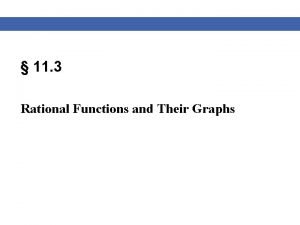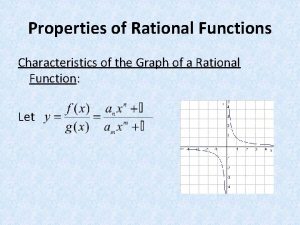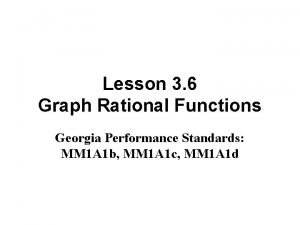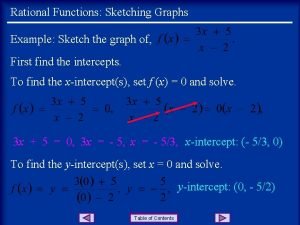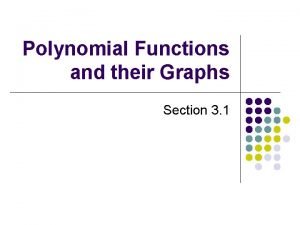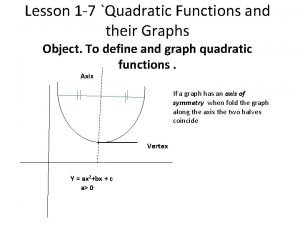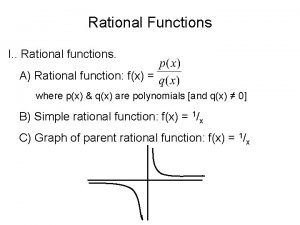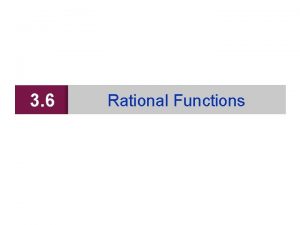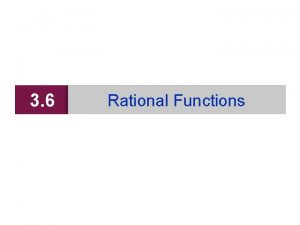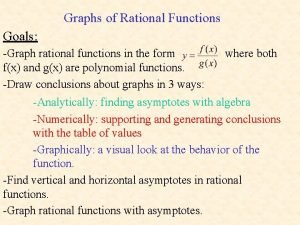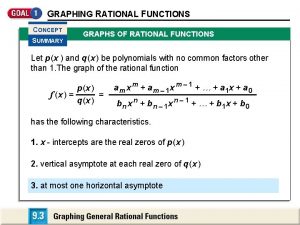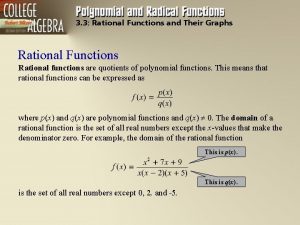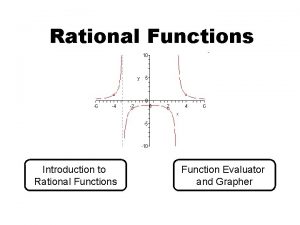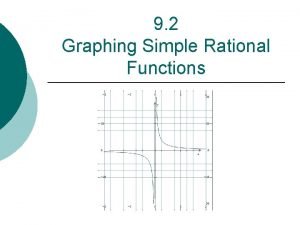3 6 Graphs of Rational Functions A rational
















- Slides: 16

3. 6 Graphs of Rational Functions

• A rational function is a quotient of two polynomial functions.

Parent function: has branches in 1 st and 3 rd quadrants. No x or y -intercepts. Branches approach asymptotes.

Vertical asymptote – the line x = a is a VA for f(x) if f(x) approaches infinity or f(x) approaches negative infinity as x approaches a from either the left or the right. The VA is where the function is undefined or the value(s) that make the denominator = 0. • Whenever the numerator and denominator have a common linear factor, a point discontinuity may appear. If, after dividing the common linear factors, the same factor remains in the denominator, a VA exists. Otherwise the graph will have point discontinuity. That means there is a hole in the Asymptote graph at that point and not an asymptote Hole

Ex 1 find any VA or holes

Horizontal Asymptote – the line y = b is a HA for f(x) if f(x) approaches b as x approaches infinity or as x approaches negative infinity. • Can have 0 or 1 HA. • May cross the HA but it levels off and approaches it as x approaches infinity.

Shortcut for HA’s • If the degree of the denominator is > the degree of the numerator then there is a HA at y = 0. • If the degree of the numerator is > the degree of the denominator then there is NO HA. • If the degree of the numerator = the degree of the denominator then the HA is y = a/b where a is the leading coefficient of the numerator & b is the LC of the denominator.

Determine the asymptotes & the x and yintercepts Degrees are equal a/b

Find asymptotes, x-int, y-int Degree is bigger in the denominator y=0

find asymptotes Degree is bigger in the denominator y=0 Degrees are equal y=a/b

Slant asymptote • There is an oblique or slant asymptote if the degree of P(x) is EXACTLY one degree higher than Q(x). • If this is the case the oblique asymptote is the quotient part of the division. • Can have 0 or 1 slant asymptote. • Can have a VA and slant, a HA and VA, but NOT a HA and slant. Either it has a slant or is has a HA

find the slant asymptote Degree is exactly one bigger in the numerator divide

Graph and find everything!! Degree is bigger in the denominator y=0 Test Points!!

Graph and find everything!!

Graph and find everything. x 2 – 3 xy – 13 x + 12 y + 39 = 0

Homework pg 313 #5 -9 odd, 15 -23 odd, 33 -39 odd, 59, 63
 5-3 polynomial functions
5-3 polynomial functions Unit 3 lesson 3 rational functions and their graphs
Unit 3 lesson 3 rational functions and their graphs Vertical answer
Vertical answer Rational functions and their graphs
Rational functions and their graphs Properties of rational function
Properties of rational function How to find horizontal asymptotes
How to find horizontal asymptotes Lesson 3 rational functions and their graphs
Lesson 3 rational functions and their graphs Testability tips in software testing
Testability tips in software testing Comparing distance/time graphs to speed/time graphs
Comparing distance/time graphs to speed/time graphs Graphs that enlighten and graphs that deceive
Graphs that enlighten and graphs that deceive Rational graphs
Rational graphs Rational function examples in real life
Rational function examples in real life Sohcahtoa choshacao
Sohcahtoa choshacao Horizontal shrink
Horizontal shrink Hyperbolic tangent
Hyperbolic tangent Types of polynomials
Types of polynomials Quadratic functions and their graphs
Quadratic functions and their graphs



